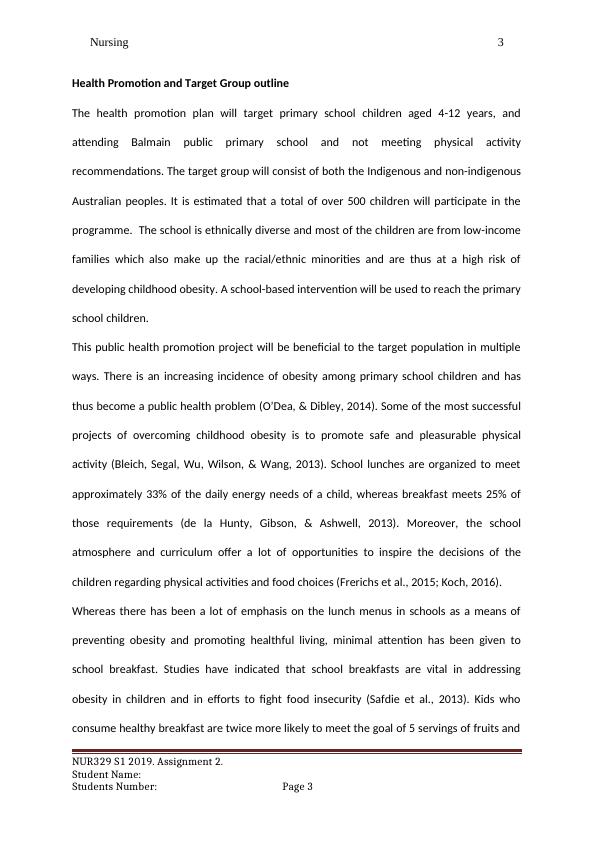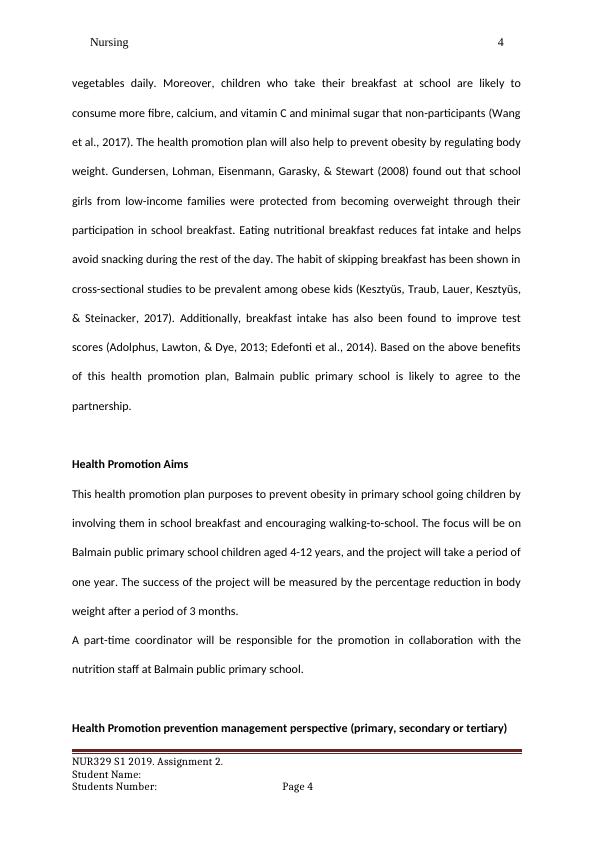Public Health Promotion Plan for Prevention of Obesity in Primary School Children
Added on 2023-01-23
14 Pages3690 Words39 Views
Running head: Nursing 1
Nursing
by
Course:
Tutor:
University:
Department:
Date:
Nursing
by
Course:
Tutor:
University:
Department:
Date:

Nursing 2
Public Health Promotion Plan for Prevention of Obesity in Primary School Children: Family
Breakfast at School and Walking School Bus
Introduction
There is an increasing global concern about the pervasiveness of obesity in school going
children in third world nations (Gortmaker et al., 2011). The Australian Institute of Health
and Welfare (2018) found out that 1 out of 4 children aged 2-17 years was overweight.
Childhood obesity is a significant public health issue because of its fast-growing incidence
and related severe medical and social impacts. Most of the existing public health strategies
for obesity prevention in school going kids have had minimal success (Swinburn et al.,
2011). The scientific community has advocated for community-based programs in the
deterrence of obesity in children (King, Gill, Allender, & Swinburn, 2011). The Colac Be
Active Eat Well is an Australian community-based programme for the aversion of obesity
among 4-12-year-old. The programme led to a minimal increase in bodyweight by 1 kg and
waist circumference by 3 cm (Sanigorski, Bell, Kremer, Cuttler, & Swinburn, 2008). More
significantly, the study did not show any indication of inequalities in health or mental
damage. Another community-based intervention programme for obesity prevention among
5-year-old children showed a substantial decline in the incidences of high BMI (de Silva-
Sanigorski et al., 2010).
The family breakfast at school project is initiative of Obesity free coalition for Children in
Balmain, NSW in collaboration with Balmain public primary school to increase the activity
level of kids and avoid obesity by promoting walking to school. The plan will also involve
intervention on healthy eating that will emphasize on promoting nutritional, and culturally
diverse school breakfasts.
NUR329 S1 2019. Assignment 2.
Student Name:
Students Number: Page 2
Public Health Promotion Plan for Prevention of Obesity in Primary School Children: Family
Breakfast at School and Walking School Bus
Introduction
There is an increasing global concern about the pervasiveness of obesity in school going
children in third world nations (Gortmaker et al., 2011). The Australian Institute of Health
and Welfare (2018) found out that 1 out of 4 children aged 2-17 years was overweight.
Childhood obesity is a significant public health issue because of its fast-growing incidence
and related severe medical and social impacts. Most of the existing public health strategies
for obesity prevention in school going kids have had minimal success (Swinburn et al.,
2011). The scientific community has advocated for community-based programs in the
deterrence of obesity in children (King, Gill, Allender, & Swinburn, 2011). The Colac Be
Active Eat Well is an Australian community-based programme for the aversion of obesity
among 4-12-year-old. The programme led to a minimal increase in bodyweight by 1 kg and
waist circumference by 3 cm (Sanigorski, Bell, Kremer, Cuttler, & Swinburn, 2008). More
significantly, the study did not show any indication of inequalities in health or mental
damage. Another community-based intervention programme for obesity prevention among
5-year-old children showed a substantial decline in the incidences of high BMI (de Silva-
Sanigorski et al., 2010).
The family breakfast at school project is initiative of Obesity free coalition for Children in
Balmain, NSW in collaboration with Balmain public primary school to increase the activity
level of kids and avoid obesity by promoting walking to school. The plan will also involve
intervention on healthy eating that will emphasize on promoting nutritional, and culturally
diverse school breakfasts.
NUR329 S1 2019. Assignment 2.
Student Name:
Students Number: Page 2

Nursing 3
Health Promotion and Target Group outline
The health promotion plan will target primary school children aged 4-12 years, and
attending Balmain public primary school and not meeting physical activity
recommendations. The target group will consist of both the Indigenous and non-indigenous
Australian peoples. It is estimated that a total of over 500 children will participate in the
programme. The school is ethnically diverse and most of the children are from low-income
families which also make up the racial/ethnic minorities and are thus at a high risk of
developing childhood obesity. A school-based intervention will be used to reach the primary
school children.
This public health promotion project will be beneficial to the target population in multiple
ways. There is an increasing incidence of obesity among primary school children and has
thus become a public health problem (O’Dea, & Dibley, 2014). Some of the most successful
projects of overcoming childhood obesity is to promote safe and pleasurable physical
activity (Bleich, Segal, Wu, Wilson, & Wang, 2013). School lunches are organized to meet
approximately 33% of the daily energy needs of a child, whereas breakfast meets 25% of
those requirements (de la Hunty, Gibson, & Ashwell, 2013). Moreover, the school
atmosphere and curriculum offer a lot of opportunities to inspire the decisions of the
children regarding physical activities and food choices (Frerichs et al., 2015; Koch, 2016).
Whereas there has been a lot of emphasis on the lunch menus in schools as a means of
preventing obesity and promoting healthful living, minimal attention has been given to
school breakfast. Studies have indicated that school breakfasts are vital in addressing
obesity in children and in efforts to fight food insecurity (Safdie et al., 2013). Kids who
consume healthy breakfast are twice more likely to meet the goal of 5 servings of fruits and
NUR329 S1 2019. Assignment 2.
Student Name:
Students Number: Page 3
Health Promotion and Target Group outline
The health promotion plan will target primary school children aged 4-12 years, and
attending Balmain public primary school and not meeting physical activity
recommendations. The target group will consist of both the Indigenous and non-indigenous
Australian peoples. It is estimated that a total of over 500 children will participate in the
programme. The school is ethnically diverse and most of the children are from low-income
families which also make up the racial/ethnic minorities and are thus at a high risk of
developing childhood obesity. A school-based intervention will be used to reach the primary
school children.
This public health promotion project will be beneficial to the target population in multiple
ways. There is an increasing incidence of obesity among primary school children and has
thus become a public health problem (O’Dea, & Dibley, 2014). Some of the most successful
projects of overcoming childhood obesity is to promote safe and pleasurable physical
activity (Bleich, Segal, Wu, Wilson, & Wang, 2013). School lunches are organized to meet
approximately 33% of the daily energy needs of a child, whereas breakfast meets 25% of
those requirements (de la Hunty, Gibson, & Ashwell, 2013). Moreover, the school
atmosphere and curriculum offer a lot of opportunities to inspire the decisions of the
children regarding physical activities and food choices (Frerichs et al., 2015; Koch, 2016).
Whereas there has been a lot of emphasis on the lunch menus in schools as a means of
preventing obesity and promoting healthful living, minimal attention has been given to
school breakfast. Studies have indicated that school breakfasts are vital in addressing
obesity in children and in efforts to fight food insecurity (Safdie et al., 2013). Kids who
consume healthy breakfast are twice more likely to meet the goal of 5 servings of fruits and
NUR329 S1 2019. Assignment 2.
Student Name:
Students Number: Page 3

Nursing 4
vegetables daily. Moreover, children who take their breakfast at school are likely to
consume more fibre, calcium, and vitamin C and minimal sugar that non-participants (Wang
et al., 2017). The health promotion plan will also help to prevent obesity by regulating body
weight. Gundersen, Lohman, Eisenmann, Garasky, & Stewart (2008) found out that school
girls from low-income families were protected from becoming overweight through their
participation in school breakfast. Eating nutritional breakfast reduces fat intake and helps
avoid snacking during the rest of the day. The habit of skipping breakfast has been shown in
cross-sectional studies to be prevalent among obese kids (Kesztyüs, Traub, Lauer, Kesztyüs,
& Steinacker, 2017). Additionally, breakfast intake has also been found to improve test
scores (Adolphus, Lawton, & Dye, 2013; Edefonti et al., 2014). Based on the above benefits
of this health promotion plan, Balmain public primary school is likely to agree to the
partnership.
Health Promotion Aims
This health promotion plan purposes to prevent obesity in primary school going children by
involving them in school breakfast and encouraging walking-to-school. The focus will be on
Balmain public primary school children aged 4-12 years, and the project will take a period of
one year. The success of the project will be measured by the percentage reduction in body
weight after a period of 3 months.
A part-time coordinator will be responsible for the promotion in collaboration with the
nutrition staff at Balmain public primary school.
Health Promotion prevention management perspective (primary, secondary or tertiary)
NUR329 S1 2019. Assignment 2.
Student Name:
Students Number: Page 4
vegetables daily. Moreover, children who take their breakfast at school are likely to
consume more fibre, calcium, and vitamin C and minimal sugar that non-participants (Wang
et al., 2017). The health promotion plan will also help to prevent obesity by regulating body
weight. Gundersen, Lohman, Eisenmann, Garasky, & Stewart (2008) found out that school
girls from low-income families were protected from becoming overweight through their
participation in school breakfast. Eating nutritional breakfast reduces fat intake and helps
avoid snacking during the rest of the day. The habit of skipping breakfast has been shown in
cross-sectional studies to be prevalent among obese kids (Kesztyüs, Traub, Lauer, Kesztyüs,
& Steinacker, 2017). Additionally, breakfast intake has also been found to improve test
scores (Adolphus, Lawton, & Dye, 2013; Edefonti et al., 2014). Based on the above benefits
of this health promotion plan, Balmain public primary school is likely to agree to the
partnership.
Health Promotion Aims
This health promotion plan purposes to prevent obesity in primary school going children by
involving them in school breakfast and encouraging walking-to-school. The focus will be on
Balmain public primary school children aged 4-12 years, and the project will take a period of
one year. The success of the project will be measured by the percentage reduction in body
weight after a period of 3 months.
A part-time coordinator will be responsible for the promotion in collaboration with the
nutrition staff at Balmain public primary school.
Health Promotion prevention management perspective (primary, secondary or tertiary)
NUR329 S1 2019. Assignment 2.
Student Name:
Students Number: Page 4

End of preview
Want to access all the pages? Upload your documents or become a member.
Related Documents
Introduction to Health Promotionlg...
|2
|621
|480
Obesity Health Promotionlg...
|4
|772
|277
Obesity and Community Childrenlg...
|1
|532
|42
EVIDENCE-BASED NURSING PRACTICE-CHILDHOOD OBESITY.lg...
|8
|1990
|85
Public health programs for obesity Assignment 2022lg...
|9
|2757
|27
Obesity Prevention Among Indigenous Childrenlg...
|10
|3670
|1
